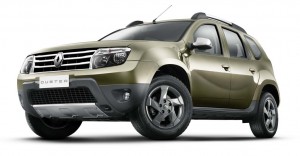
Renault's new Duster 4x4 is part of an aggressive product program aimed at Brazil that will see it - and Nissan - launch 23 new models.
Nissan and its alliance partner Renault will invest $1.8 billion in an aggressive campaign to double their market share in the booming Brazilian auto market over the next five years.
Expanding upon earlier announcements, the two makers will launch 23 new models and expand their combined production capacity to 580,000 vehicles annually.
“Brazil represents a tremendous opportunity – both as a manufacturing base and as the home of a new generation of Renault and Nissan customers,” said Carlos Ghosn, who serves as CEO of both Nissan and Renault, during an announcement in Rio de Janeiro. “Brazil weathered the recession and emerged as the clear engine of growth for Latin America in the 21st century. We look forward to contributing to the region’s rapidly evolving manufacturing and technological expertise.”
Fueled by its fast-growing middle-class, automotive demand in Brazil has been red hot and that’s leading makers to commit to invest billions to boost their production capacity. But could they heading for trouble? The market has seen some unexpected slowdowns this year which raises concerns about Brazil’s ability to maintain its momentum at a time when much of the rest of the global economy – even China – is showing signs of trouble.
But Ghosn – who is a Brazilian native – is clearly convinced the market can overcome its problems. With a population of 190 million, Brazil has become the largest economy in Latin America, in large part due to a 25% growth in its middle class over the past decade. Vehicle ownership surged from 121 per thousand in 2002 to 158 by 2008.
Today’s big announcement is a planned $285 million investment by Renault to expand its factory in Curtiba, in the state of Parana. When that’s completed in 2013 it will have capacity to produce 380,000 vehicles annually. That’s on top of another $571 million 5-year product program set to wrap up in 2015.
In 2010, Brazil pushed past Germany to become the world’s fourth-largest national automotive market. The Latin American nation is already Renault’s second-largest market. With the expansion program, its employment there will expand by 1,000 to 7,000.
Nissan CEO Ghosn had previously promised to add a new Nissan plant in Brazil to supplement a Mexican plant that currently ships vehicle to the Portugese-speaking market. Its factory will begin operations in 2014, with a 200,000 unit capacity, and will employ 2,000.
Together, the two companies plan to add 23 new models by 2016 – 13 badged Renault, 10 as Nissans — many sharing the same underlying platforms, as they do in other parts of the world.
The makers also intend to double their current dealer count. Nissan now has 117 outlets, Renault 186.
Counted together, the Renault-Nissan Alliance held a 5.9% stake in the Brazilian market in 2010, when they sold a combined 196,204 vehicles. That positions the partners in fifth place. The market leaders are:
- Fiat, at 22.8%, with 2010 sales of 760,146 vehicles;
- Volkswagen, at 20.9%, with sales of 697,283;
- General Motors, at 19.8%, with sales of 657,769; and
- Ford, at 10.1%, with sales of 336,354.
Nissan is far from alone in sensing opportunities in Samba-land. Its alliance partner Renault intends to add another 70,000 units of capacity over the next four years, while Fiat will boost capacity 350,000. GM, which currently has 850,000 units of capacity in place in Brazil will boost that figure by another 150,000.
Other makers looking to grow their capacity include Volkswagen, Ford, Toyota – and two fast-emerging Asian marques, Hyundai and Chery.
The South Korean maker will more than double its potential output, to 280,000 vehicles annually, reports Deutsche Bank, while Chery, a newcomer to Brazil, soon hopes to be producing 200,000 vehicles a year.
